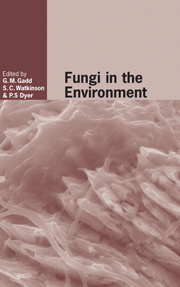Book contents
- Frontmatter
- Contents
- List of contributors
- Preface
- I Imaging and modelling of fungi in the environment
- II Functional ecology of saprotrophic fungi
- III Mutualistic interactions in the environment
- IV Pathogenic interactions in the environment
- 11 Functional genomics of plant infection by the rice blast fungus Magnaporthe grisea
- 12 Exploring the interaction between nematode-trapping fungi and nematodes by using DNA microarrays
- 13 Role of α(1-3)-glucan in Aspergillus fumigatus and other human fungal pathogens
- 14 Plagues upon houses and cars: the unnatural history of Meruliporia incrassata, Serpula lacrymans and Sphaerobolus stellatus
- V Environmental population genetics of fungi
- VI Molecular ecology of fungi in the environment
- Index
- References
13 - Role of α(1-3)-glucan in Aspergillus fumigatus and other human fungal pathogens
from IV - Pathogenic interactions in the environment
Published online by Cambridge University Press: 03 November 2009
- Frontmatter
- Contents
- List of contributors
- Preface
- I Imaging and modelling of fungi in the environment
- II Functional ecology of saprotrophic fungi
- III Mutualistic interactions in the environment
- IV Pathogenic interactions in the environment
- 11 Functional genomics of plant infection by the rice blast fungus Magnaporthe grisea
- 12 Exploring the interaction between nematode-trapping fungi and nematodes by using DNA microarrays
- 13 Role of α(1-3)-glucan in Aspergillus fumigatus and other human fungal pathogens
- 14 Plagues upon houses and cars: the unnatural history of Meruliporia incrassata, Serpula lacrymans and Sphaerobolus stellatus
- V Environmental population genetics of fungi
- VI Molecular ecology of fungi in the environment
- Index
- References
Summary
Introduction
The fungal cell wall has been considered for a long time as an inert organelle but recent studies, mainly based on the analysis of the yeast cell wall, suggest that it is indeed a dynamic structure where constitutive polymers are continuously chemically modified and rearranged during morphogenesis. The cell wall plays an essential role in sensing adverse or favourable environments. In particular, it provides the fungus with adaptative responses to variable osmotic pressures and other stress factors including host defence reactions. The cell wall is continuously in contact with the host and acts also as a sieve and a reservoir for molecules such as enzymes, antigens, and elicitors or toxins that play an active role during infection (Mouyna & Latgé, 2001).
The major component of the cell wall is polysaccharide. It accounts for over 90% of the cell wall mass and and consists of three basic components: glucans, mannan and chitin (Fig. 13.1). The fibrillar skeleton of the cell wall is considered to be the alkali-insoluble fraction, whereas the material in which the fibrils are embedded is alkali-soluble (Fontaine et al., 2000). The central core of the cell wall is branched β1,3, β1,6 glucans that are linked to chitin via a β(1–4) linkage (Fontaine et al., 2000). This core is present in most fungi, and at least in all ascomycetes and basidiomycetes. The alkali-soluble amorphous cement varies with the fungal species; its composition has been analysed in few fungal species.
- Type
- Chapter
- Information
- Fungi in the Environment , pp. 269 - 288Publisher: Cambridge University PressPrint publication year: 2007
References
- 4
- Cited by



